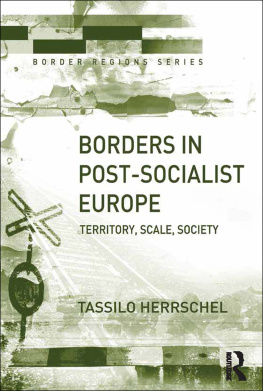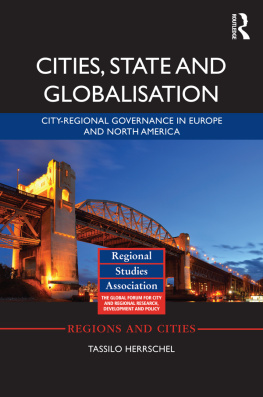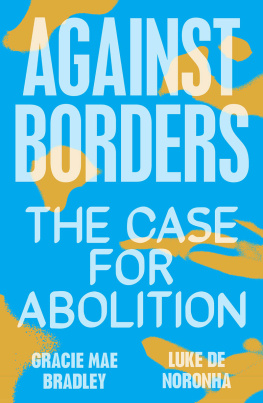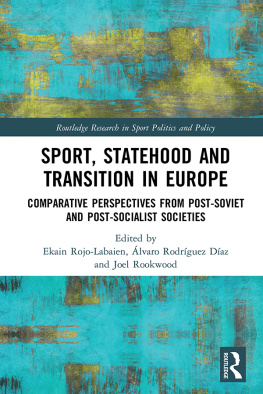BORDERS IN POST-SOCIALIST EUROPE
Border Regions Series
Series Editor: Doris Wastl-Walter, University of Bern, Switzerland
In recent years, borders have taken on an immense significance. Throughout the world they have shifted, been constructed and dismantled, and become physical barriers between socio-political ideologies. They may separate societies with very different cultures, histories, national identities or economic power, or divide people of the same ethnic or cultural identity.
As manifestations of some of the worlds key political, economic, societal and cultural issues, borders and border regions have received much academic attention over the past decade. This valuable series publishes high quality research monographs and edited comparative volumes that deal with all aspects of border regions, both empirically and theoretically. It will appeal to scholars interested in border regions and geopolitical issues across the whole range of social sciences.
Borders in Post-Socialist Europe
Territory, Scale, Society
TASSILO HERRSCHEL
University of Westminster, UK
First published 2011 by Ashgate Publishing
Published 2016 by Routledge
2 Park Square, Milton Park, Abingdon, Oxon OX14 4RN
711 Third Avenue, New York, NY 10017, USA
Routledge is an imprint of the Taylor & Francis Group, an informa business
Copyright Tassilo Herrschel 2011
Tassilo Herrschel has asserted his right under the Copyright, Designs and Patents Act, 1988, to be identified as the author of this work.
All rights reserved. No part of this book may be reprinted or reproduced or utilised in any form or by any electronic, mechanical, or other means, now known or hereafter invented, including photocopying and recording, or in any information storage or retrieval system, without permission in writing from the publishers.
Notice:
Product or corporate names may be trademarks or registered trademarks, and are used only for identification and explanation without intent to infringe.
British Library Cataloguing in Publication Data
Herrschel, Tassilo, 1958-
Borders in post-socialist Europe : territory, scale, society.--(Border regions series)
1. Europe, Eastern--Boundaries. 2. Russia (Federation)--Boundaries. 3. Former communist countries--Boundaries.4. Human territoriality--Europe, Eastern. 5. Human territoriality--Russia (Federation) 6. Human geography--Europe, Eastern. 7. Human geography--Russia (Federation)
I. Title II. Series
304.230947-dc22
Library of Congress Cataloging-in-Publication Data
Herrschel, Tassilo, 1958-
Borders in post-socialist Europe : territory, scale, society / by Tassilo Herrschel.
p. cm. -- (Border regions series)
Includes bibliographical references and index.
ISBN 978-0-7546-4384-5 (hardback : alk. paper) -- ISBN 978-1-3155-6974-1 (ebook) 1. Post-communism--Social aspects--Europe, Eastern. 2. Europe, Eastern--Boundaries. I. Title.
HN380.7.A8H47 2011
303.4824009049--dc22
2011013143
ISBN 9780754643845 (hbk)
ISBN 9781315569741 (ebk)
ISBN 9781317173106 (ebk-ePUB)
Contents
List of Figures and Tables
Figures
Tables
Acknowledgements
The author would like to express deep gratitude to the Publishers, especially the Commissioning Editor, Valerie Rose, for the repeated extension of deadlines over several years as an expression of belief in the eventual delivery of the manuscript.
Many thanks go also to friends and family for their continued support and encouragement.
Lastly, the author would like to acknowledge the use in of results of research interviews conducted by Benjamin Gore with policy makers in the Baltic Sea Region, while a PhD candidate.
Introduction
This book has taken much longer to write than was originally envisaged and it has not been an easy project, changing considerably in format and contents since its first design. It started off as a conference-inspired project involving the author and two co-authors. The idea was to bring together different insights gained by the three authors from their work on borders and transition in post-communist Eastern Europe. Russian borders had attracted particular attention, as they experienced particularly far-reaching processes of re-bordering under the impression of the considerable geo-political and geo-economic changes that had swept across Eastern Europe since the end of the communist regimes. Yet, interests changed and the book turned into a single author project with a stronger politicaleconomic, rather than culturalhistorical perspective, as had initially been envisaged. Nevertheless, the main focus remained on the differentiating effect of a growing influence and impact of the European Union on Eastern Europe. This included in particular the EUs concept and practice of integration, and the effect that has had on national borders within and immediately outside its territory as it shifted eastwards to the edge of the territory of the former Soviet Union. This process changed fundamentally, and was intended and employed to do so, creating a new sense of positioning and belonging between the two poles of Moscow and Brussels. Much of this rejoining of Europe, as it was termed and propagated across Eastern Europe, was intended as a highly symbolic act of moving away from the Soviet, that is de facto Russian, embrace of the post-war period of nearly half a century, and signalling a new, or, as it has been portrayed and understood, restored, connectivity with Western Europe. And that has stood as proxy for the West in general, and America, in particular. In return, as a consequence of the nature of the European Unions internal integration process, separateness from the outside became stronger, thus producing, and clearly signifying, new divisions emerging in Europe. The most prominent among these is the European Unions external border which now coincides with the western border of the former Soviet Union. Because of its fortress-like nature, it has also been dubbed as the new Iron Curtain. This name also evokes the old contrast between Western (US) and Eastern (Soviet) Blocs in the light of todays reference to spheres of influence along that border, especially from a more assertive Russia.
These changes in borderness as the product of quality and effect of borders, and their implementation on the ground, have become particular obvious in the Baltic States. There, the clear objective has been to redefine the border with Russia as EU external as an affirmation of their leaving the Soviet Union and joining (Western) Europe. While joining the European Union may be viewed by some as a loss of hard won sovereignty, it also signals a Westernisation, a new connectivity and belonging, and a breaking with the period of involuntary Soviet embrace. Inevitably, these wider geo-political shifts in their meanings and realities on the ground have had considerable effects along the new EU external border, felt most keenly where they occur in a highly localised environment, such as urban areas separated by the new border quality. Yet these changes, especially in the Baltic States, also created less visible, but equally felt, divisions and thus inclusions and exclusions between different parts of society in particular those representing the Soviet and that is







